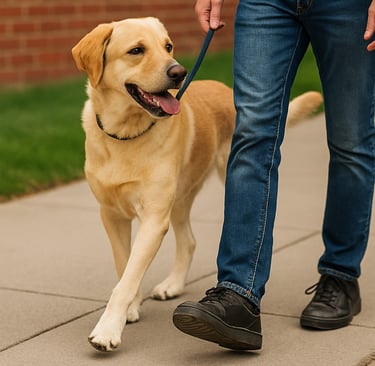How Do I Stop My Dog from Pulling on the Leash?
Learn why dogs pull on the leash and how to fix it. Discover which tools help (and which hurt), and follow a step-by-step guide to teaching leash pressure and the heel command.
John
11/17/20256 min read


Leash pulling is one of the most common and frustrating problems dog owners deal with. You clip the leash on, take one step outside, and suddenly your calm dog turns into a sled dog. The walk becomes more about survival than structure — and it’s definitely not enjoyable for either of you.
But pulling isn’t just a bad habit. It’s a communication issue. And if it’s not addressed, it teaches your dog that ignoring you and dragging you around works.
So let’s talk about why dogs pull, what tools actually help, which ones don’t, and how to teach your dog to walk politely by your side.
Why Dogs Pull on the Leash
Dogs pull because it works. It gets them where they want to go. They see a squirrel, smell something interesting, or just want to move faster — so they lean into the leash and pull forward. And most people unknowingly reinforce that behavior by following them.
Dogs also pull because no one’s ever taught them what leash pressure means. If a dog doesn’t understand that the tension on the leash is a signal to check in or slow down, they just ignore it — or worse, fight against it.
Pulling is often a mix of excitement, lack of boundaries, and missing communication. The good news is that with the right tools and training, you can fix it.
Let’s Talk About Tools
There are a lot of leash tools out there. Some are designed for comfort. Others are designed for control. But not all tools are helpful when your goal is to teach your dog how to walk respectfully on a leash.
Here’s a breakdown of the most common ones — and why some of them may actually make pulling worse.
❌ Flat Collars
Flat collars are for ID tags — not training. They apply all the pressure to your dog’s neck with no control and no communication. When a dog pulls in a flat collar, they usually just choke themselves and ignore it.
Even worse, repeated pulling on a flat collar can cause irreversible tracheal damage. That kind of damage affects your dog’s ability to breathe properly and cool themselves down, especially in warmer weather or during exercise. It’s not just ineffective — it’s unsafe.
If your dog is a strong puller, a flat collar puts pressure exactly where it can do the most harm and the least good.
❌ Back‑Clip Harnesses
Back‑clip harnesses were designed for comfort, not control. All the pressure is placed across the chest and shoulders — the exact areas built to generate power. That’s why sled dogs wear harnesses.
When you use a back‑clip harness on a dog that pulls, you’re actually making it more comfortable for them to drag you around. It removes any meaningful feedback and turns the walk into a strength contest that you’ll never win. Your dog gets rewarded every time they lean their body weight into it.
Back‑clip harnesses don’t teach your dog anything about leash pressure, focus, or slowing down. They simply make pulling easier, and the habit gets reinforced every single step.
❌ Gentle Leaders / Head Halters
Head halters give the illusion of control because they redirect the dog’s head, but they rarely teach the dog how to walk calmly on their own. Most dogs find them uncomfortable or irritating, and they learn to comply out of avoidance — not understanding.
From my experience working with hundreds of leash‑pulling dogs, dogs that have been walked on head halters are often more difficult to teach proper leash manners later on.
Why?
Because the halter restricts their movement so much that when you finally take it off, they become overwhelmed by the freedom. Instead of being calmer, they become more stimulated, more distracted, and have a harder time focusing because the halter never taught them how to respond to leash pressure — it only prevented them from pulling.
And despite the comparison people like to make, dogs are not horses. They do not respond to halters the same way. A dog’s neck anatomy is different, their instinctual responses are different, and head halters can create sharp angles of pressure that lead to strain or neck problems.
A tool that prevents a behavior is not the same as a tool that teaches a behavior — and head halters fall into the first category.
So What Tools Do Work?
The right tool depends on your dog, but for leash training and teaching the heel command, I recommend equipment that allows for clear, consistent communication through leash pressure — usually a training collar (slip, prong, or pressure collar) used fairly and paired with proper technique.
Used correctly, these tools help your dog understand the conversation happening through the leash: when to slow down, when to check in, and when to follow your lead. They’re not meant to correct or hurt the dog — they’re meant to create clarity.
Teaching Leash Pressure: Step by Step
Before teaching heel, your dog needs to understand leash pressure. That means teaching them that pressure is a cue, not a punishment. Most dogs have never been taught this — they just feel pressure and pull harder.
Step 1: Teach Pressure and Release
Stand in a quiet space with minimal distractions.
Apply light leash pressure in one direction (sideways or back).
The moment your dog gives in to the pressure — even a small step — release it instantly.
Mark that moment with a “yes” or a click, and reward.
Repeat this from different angles. Your dog should start to learn that pressure = follow.
This foundation is critical. If your dog doesn’t understand how to yield to leash pressure, they’ll continue fighting it during walks.
Teaching the Heel Command
Once your dog understands leash pressure, you can start teaching the heel position — walking beside you with focus and a loose leash.
Step 2: Introduce Heel in a Calm Space
Choose which side you want your dog to walk on (traditionally the left).
With the leash in one hand and a few treats in the other, guide your dog to your side.
Start walking in a straight line. The moment your dog walks next to you without tension, mark and reward.
If they move ahead or lag behind, use leash pressure and your body movement to guide them back into place — then release pressure once they’re there.
Step 3: Add Direction Changes
Change directions frequently — left turns, right turns, 180 turns.
This teaches your dog to pay attention to your movement instead of marching ahead.
Reward focus and position, not just walking.
Step 4: Add Distractions Over Time
Don’t go straight to a busy street. Gradually add distractions in new environments.
Use leash pressure, changes of direction, and the “sit” command as resets.
Keep sessions short and structured. Quality matters more than quantity.
What to Expect
Teaching a dog to walk nicely on leash takes time and repetition. You’re building muscle memory — not just physical, but mental. Some dogs catch on quickly. Others need more time, especially if they’ve been pulling for years.
Expect mistakes. Expect testing. That’s normal. Your job is to stay consistent, be fair, and keep the communication clear.
Over time, your dog will learn that being by your side is rewarding, calm, and easy. You’ll spend less time managing chaos — and more time actually enjoying your walks.
A Quick Note Before You Start
Every dog is different.
Their personality, drive, past experiences, and level of sensitivity all play a role in how they respond to different tools and techniques. What works well for one dog may need to be adjusted for another.
This blog is meant to be a general guide — something to help you understand the concepts behind leash pressure, training tools, and the heel command. But depending on your dog’s temperament and behavior, some things may need to be tweaked or approached differently.
If you're unsure which tools are best for your dog, or you feel stuck during the training process, don’t hesitate to reach out to a professional. Getting it right early saves you time, frustration, and stress — for both you and your dog.
Final Thoughts
If your dog is pulling on the leash, it’s not just a behavior issue — it’s a breakdown in communication. The right training tools, paired with clear leash pressure and consistent handling, can turn a stressful walk into a smooth one.
Teaching your dog to walk nicely isn’t about control. It’s about leadership, trust, and clarity. When your dog understands what’s expected and how to respond, they stop pulling — not because they’re forced to, but because it finally makes sense.
Need Help?
If you're tired of being dragged on walks and want real, lasting change, I can help. Whether it’s one-on-one coaching or my board and train program, I’ll show you how to rebuild the walk from the ground up — in a way that makes sense for both you and your dog.
📞 Call: (813) 796 1006
